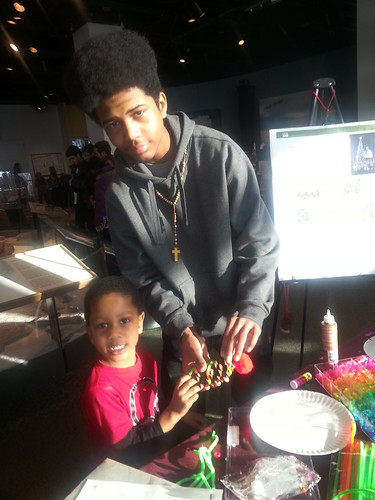This post is part of the Science Tuesday feature series on the USDA blog. Check back each week as we showcase stories and news from the USDA’s rich science and research portfolio.
A pine cone has many purposes. It could serve as a home for birds and insects. Pine cones contain seeds to use in reforestation projects. They even can be made into fanciful ornaments to adorn the 2014 Capitol Christmas Tree.
That’s exactly what students learned during a recent Science Fusion program at the Science Museum of Minnesota.
As part of an overarching mission to the world of science, technology, engineering and math, these special Saturday programs afford underserved Minnesota youth the opportunity to interact with local scientists, engineers, inventors and science educators through hands-on activities.
The Minnesota Department of Natural Resources got involved by donating white pine cones to be used in creating the ornaments. But nothing is left to waste.
“The seeds have been removed to be used in reforestation projects across the state,” said Teri Heyer, with the U.S. Forest Service’s Urban Connections program.
The pine cone project was especially significant given that this year’s Capital Christmas tree will come from Minnesota’s Chippewa National Forest.
A generation has passed since a tree from Minnesota has been placed at the U.S. Capitol as part of the annual holiday celebrations. In 1992, the Chippewa National Forest and Leech Lake Reservation sent a 60-foot white spruce along with thousands of ornaments made by local school children.
“The forest is very excited to have this opportunity again,” said Forest Supervisor Darla Lenz. “The 2014 Capitol Christmas tree is a great opportunity to showcase Minnesota in our nation’s capital. Thousands of ornaments representing Minnesota will be created by people from all over the state for this project. What better way for our residents to share what their home means on a national stage.”
Groups, organizations and individuals interested in helping with the year-long celebration and planning for the 2014 Capitol Christmas Tree may contact Michael Theune on the Chippewa National Forest, by email at michaeljtheune@fs.fed.us.
The Forest Service is a proud partner of Science Fusion Saturdays as it provides an opportunity to talk about natural resources with urban youth, and share Forest Service career information.
Providing the U.S. Capitol Christmas Tree is a labor of love that begins up to two years in advance. A team in the Forest Service headquarters in Washington, D.C., coordinates with field employees from the chosen forest. No tax dollars are used. However, Forest Service employees are assigned to help oversee the project.

